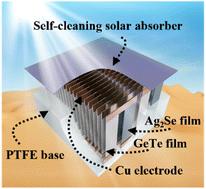用于极端环境的高集成GeTe薄膜热电器件
IF 9.5
2区 材料科学
Q1 CHEMISTRY, PHYSICAL
引用次数: 0
摘要
热电薄膜为自供电器件的应用提供了广阔的前景。然而,它们的低集成密度对实现高电输出构成了重大挑战。在这里,我们提出了一个高度集成的,垂直结构的热电薄膜器件,包括p型Ge0.98Bi0.02Te和n型Ag2Se薄膜。优化后的Ge0.98Bi0.02Te薄膜具有较高的室温功率因数,为~ 26.1 μW cm−1 K−2,这是由于Bi掺杂有效降低了载流子浓度。当与自清洁太阳能吸收器相结合时,该装置有效地捕获太阳能,在室外条件下在热电腿上建立32 K的明显温差。该结构于2025年6月2日在中国深圳(114.31°E, 22.59°N)实现了高开路电压密度(~ 25.7 mV cm - 2)和功率密度(~ 2.5 mW cm - 2),这是由于Ge0.98Bi0.02Te和Ag2Se薄膜具有优越的室温TE性能,以及高器件集成密度(~ 4.4对/ cm2)。此外,自清洁太阳能吸收器增强了环境弹性,即使在恶劣的沙漠条件下也能保持一致的性能。这些发现强调了gete基热电薄膜在可持续能源收集和发电方面的潜力,特别是在极端气候下。本文章由计算机程序翻译,如有差异,请以英文原文为准。

Highly integrated GeTe thin-film thermoelectric devices for extreme environments
Thermoelectric thin films offer promising potential for self-powered device applications. However, their low integration density poses a significant challenge in achieving high electrical output. Herein, we present a highly integrated, vertically structured thermoelectric thin-film device comprising p-type Ge0.98Bi0.02Te and n-type Ag2Se films. The optimized Ge0.98Bi0.02Te films exhibit a high room-temperature power factor of ∼26.1 μW cm−1 K−2, attributed to the effective reduction in carrier concentration by Bi doping. When coupled with a self-cleaning solar absorber, the device efficiently captures solar energy, establishing a pronounced temperature difference of 32 K across the thermoelectric legs under outdoor conditions. This configuration delivered a high open-circuit voltage density of ∼25.7 mV cm−2 and a power density of ∼2.5 mW cm−2 in Shenzhen China (114.31° E, 22.59° N) on June 2, 2025, due to the superior room-temperature TE performance of both Ge0.98Bi0.02Te and Ag2Se films, as well as a high device integration density of ∼4.4 pair per cm2. Moreover, the self-cleaning solar absorber enhances environmental resilience, enabling consistent performance even under harsh desert conditions. These findings underscore the potential of GeTe-based thermoelectric thin films for sustainable energy harvesting and power generation, particularly in extreme climates.
求助全文
通过发布文献求助,成功后即可免费获取论文全文。
去求助
来源期刊

Journal of Materials Chemistry A
CHEMISTRY, PHYSICAL-ENERGY & FUELS
CiteScore
19.50
自引率
5.00%
发文量
1892
审稿时长
1.5 months
期刊介绍:
The Journal of Materials Chemistry A, B & C covers a wide range of high-quality studies in the field of materials chemistry, with each section focusing on specific applications of the materials studied. Journal of Materials Chemistry A emphasizes applications in energy and sustainability, including topics such as artificial photosynthesis, batteries, and fuel cells. Journal of Materials Chemistry B focuses on applications in biology and medicine, while Journal of Materials Chemistry C covers applications in optical, magnetic, and electronic devices. Example topic areas within the scope of Journal of Materials Chemistry A include catalysis, green/sustainable materials, sensors, and water treatment, among others.
 求助内容:
求助内容: 应助结果提醒方式:
应助结果提醒方式:


